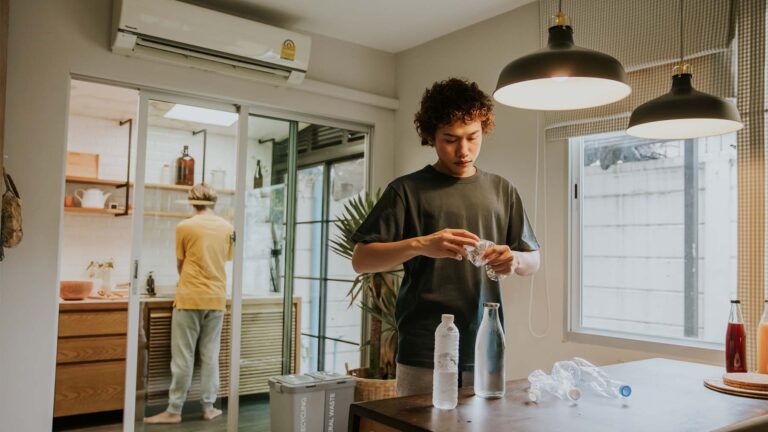
Sustainability at home: Recycling is a good start. (Photo/iStock)
Sustainable shelter: How these USC experts are living green at home
EARTH WEEK: Installing low-flow shower heads and LED lightbulbs and adjusting the thermostat are just a few things you can do to live more sustainably. Find out how USC experts are making a difference where they live.
Shon Hiatt walks the sustainability walk.
From the backyard of the 1,430-square-foot Manhattan Beach home Hiatt shares with his wife and seven children ages 3-17, an energized Hiatt details the various steps he’s taken to create a more sustainable home.
He points to LED lightbulbs and 1.5-gallon showerheads, a rain-collecting water barrel he uses to water rose and blueberry bushes, a graywater system that transforms water from showers and baths into liquid nourishment for the property’s fruit trees and a front yard in which Hiatt himself replaced grass with bark.
Inspired by his upbringing on an Idaho farm where “reduce, reuse, recycle” was engrained in daily life, a faith-fueled drive to be a responsible steward of the Earth and an earnest interest in self-reliance, Hiatt sees a more sustainable home as a personal mission.
“A commitment to sustainability is deep within me and directs many of my actions,” said Hiatt, an associate professor of management and organization at the USC Marshall School of Business. “And it doesn’t hurt that many of these choices save me bit of money, too.”
Free resources for a green home
Whether one rents or owns, some eco-conscious solutions remain accessible to anyone willing to blend intentionality, awareness and pinches of sacrifice to support the planet.
On the West Coast in particular, water earns substantial attention — and for good reason. Much of California faces severe drought conditions, and federal authorities have issued troubling outlooks for the Colorado River, a main source of fresh drinking water for Californians.
To spur water conservation, California Water Service (Cal Water), the state’s largest water utility, provides single-family residential customers free kits packed with water-saving tools, such as high-efficiency showerheads, faucet aerators and leak-detection dye tablets. Those solutions, combined with mindful daily changes like turning off water while tooth brushing, can help California residents protect a precious, though dwindling, natural resource.
While Kelly Sanders, an associate professor of civil and environmental engineering at the USC Viterbi School of Engineering, said California building codes requiring items like low-flow showers and toilets have bolstered water conservation indoors, immense potential exists to reduce outdoor water use. Watering the lawn at night, for instance, reduces evaporation, while Cal Water’s Smart Landscape Tune-Up Program helps homeowners make irrigation system efficiency improvements at no charge.
On the energy front, Wändi Bruine de Bruin, Provost Professor of Public Policy at the USC Price School of Public Policy and the Department of Psychology at the USC Dornsife College of Letters, Arts and Sciences, said residents bickering about who left the kitchen lights on should instead direct their attention to a bigger energy-sucking culprit: home heating and air conditioning.
We can all make choices every day to improve the sustainability of our homes.
Wändi Bruine de Bruin, Provost Professor
Residents can reduce heating and cooling loads by closing blinds and curtains during hot days and opening windows for natural ventilation during cool nights. While such measures require residents to recalibrate their expectations of the constant 72-degree home, the changes cost nothing and, in fact, generate savings.
Other energy-saving practices include using cold water for laundry, swapping the dryer for a clothesline or drying rack and turning off devices when not in use, especially since “phantom energy” can account for up to 20% of a home’s monthly energy usage.
“We can all make choices every day to improve the sustainability of our homes,” Bruine de Bruin said.
Taking the next steps toward living sustainably
While changing daily activities remains the most accessible way to create a more sustainable home, residents can safeguard natural resources and combat climate change with some strategic home investments, many of which feature money-saving programs.
To further reduce water use, homeowners might lean into drought-tolerant landscaping and native plants. The Turf Replacement Program from the Los Angeles Department of Water and Power offers a rebate of $3 per square foot to homeowners replacing grass with a sustainable landscape, which helps recharge groundwater, reduces urban runoff, enhances wildlife habitats and lowers water bills.
Many local gardening centers can help residents craft a sustainable landscape plan, while the LADWP also provides free online classes on topics such as garden design, irrigation and native plants. Sustainability-minded homeowners can also get an assist from local programs. City Plants, for example, provides free trees to bring shade or windbreaks to L.A. properties, while some agencies distribute free rain barrels to address irrigation needs. Hiatt grabbed his rain barrel from the West Basin Municipal Water District.
Inside the home, Bhavna Sharma, an assistant professor at the USC School of Architecture, urged residents to conduct online assessments to inventory their home’s water consumption and identify potential improvements. LADWP offers “how-to” videos for water audits and leak checks. Rebate programs like Cal Water’s $100 rebate on high-efficiency toilets can trim the expense of purchasing new fixtures or appliances.
Many utilities, including LADWP and SoCalGas, offer home energy improvement assessments to propel resource-minded energy usage. In some cases, the utilities even install energy-saving devices free of charge.
While switching to more energy-efficient LED lightbulbs and installing a smart thermostat are undoubtedly worthwhile ventures, routine home maintenance is critical. Annual service of heating and air conditioning units and regularly changing air filters helps the home’s mechanicals operate at peak efficiency. Sealing cracks around doors and windows, meanwhile, reduces drafts and cold spots, enhancing comfort and saving energy.
“These aren’t necessarily sexy changes, but they’re beneficial,” Sanders said.
And if certain energy-hogging appliances or mechanicals need replacement, rebate programs can soften the investment. Cal Water’s rebates include up to $300 for high-efficiency washing machines, while LADWP’s Refrigerator Exchange Program supplies a free energy-efficient refrigerator in exchange for qualified older models.
Readying for bigger leaps to sustainability at home
In Los Angeles, where buildings account for more than 40% of the city’s total greenhouse gas emissions, property owners have a growing list of incentives encouraging them to take even more ambitious steps toward sustainable residences.
Homeowners with the means to retrofit their homes might install energy-efficient windows or upgrade home insulation. A thermographic inspection will identify insulation needs, while certain public programs defray costs. The U.S. Department of Energy, which hosts various rebate programs designed to spur energy-efficient living, offers a 10% tax credit up to $500 on qualified insulation purchases.
In California, one of the best places in the world to harness sunlight for electrical power, solar electricity continues gaining mainstream attention. Though converting to solar power requires a substantial investment, some existing feed-in tariffs — which provide homeowners a guaranteed price for the energy they deliver to the grid — and financing plans alleviate the hefty cost of installing solar power, said Josh West, professor of Earth sciences and environmental studies at USC Dornsife. Among the many cost-reducing programs for solar-powered products are the $3,500-$4,500 rebate SoCalGas offers its customers purchasing an Energy Star-certified solar thermal system with a gas water heater backup.
“These one-time decisions require a significant investment, but then you don’t have to think about them again,” Bruine de Bruin said.
The hope is that people scale up their commitment to sustainability.
Josh West, USC Dornsife professor
of Earth sciences and environmental studies
The most powerful opportunity to drive sustainable shelter, however, begins with new construction, when homeowners can invest in eco-friendly solutions such as geothermal heat pumps for more efficient heating and cooling, as well as greywater systems to better utilize water resources.
“New construction is the moment where you can really make a significant impact,” West said, though he acknowledged building a new home in Los Angeles isn’t realistic for most. “Still, the hope is that people scale up their commitment to sustainability, starting small with conscious choices to conserve water and energy before incorporating other investments as they have the means to do so.”



